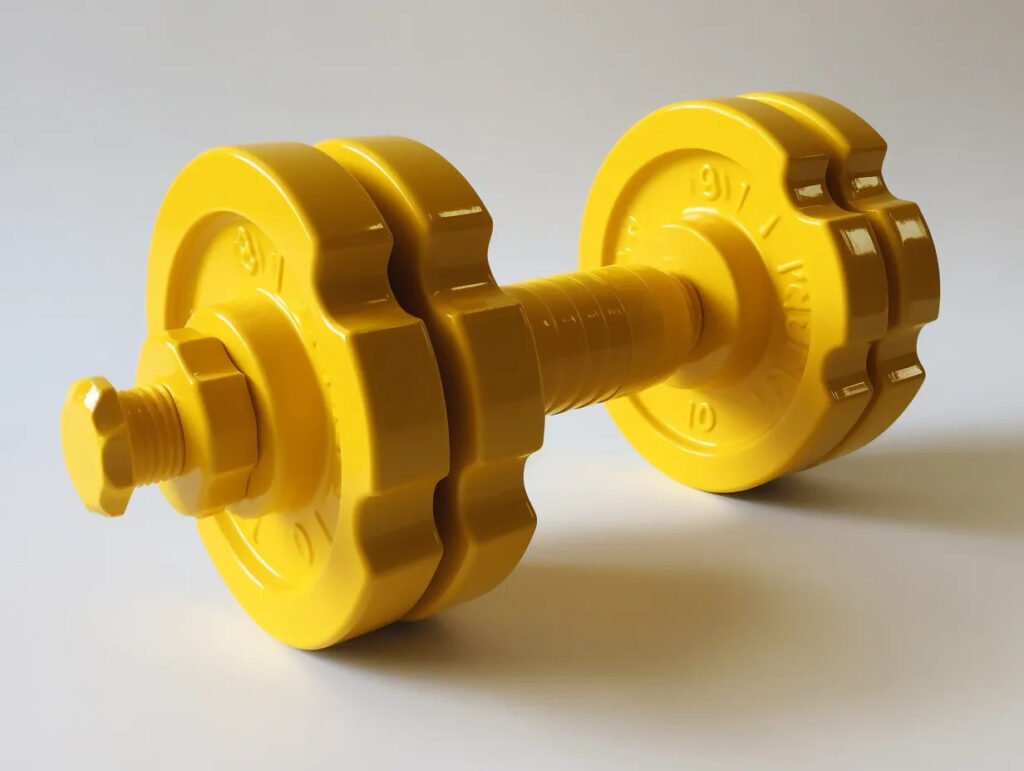
Introduction to Dog Obedience Training with Dumbbells
Dog obedience training is an essential part of ensuring a well-behaved and happy canine companion. While there are various training tools available, incorporating dumbbells into your dog’s training regimen can provide numerous benefits. Not only does it help build strength and endurance, but it also stimulates your dog’s mind and strengthens the bond between you and your furry friend. In this article, we will explore the basics of using dog dumbbells in obedience training and discuss the benefits of incorporating them into your dog’s routine.
Key Takeaways
- Using dumbbells in dog obedience training can help build strength and endurance.
- Dumbbell training provides mental stimulation and keeps your dog’s mind sharp.
- Incorporating dumbbells into training strengthens the bond between you and your dog.
- Choose the right dumbbell size and weight for your dog to ensure effective training.
- Ensure safety by maintaining a secure grip and proper form when using dumbbells with your dog.
Choosing the Right Dumbbell
Size Matters: Picking the Perfect Dumbbell for Your Pooch
When it comes to dumbbells for your four-legged friend, size matters. Just like humans, dogs come in all shapes and sizes, so it’s important to find a dumbbell that is tailor-made for your pooch. A small dog may need a lighter dumbbell, while a larger dog may require something more substantial. Don’t be fooled by appearances! It’s not about the size of the dog, but rather the size of their mouth and paws. To help you make the right choice, here’s a handy table to determine the perfect dumbbell size based on your dog’s weight:
| Dog Weight (lbs) | Dumbbell Size |
|---|---|
| 0-10 | Small |
| 11-25 | Medium |
| 26+ | Large |
Remember, it’s not about the weight of the dumbbell, but how your dog feels comfortable lifting it. So, grab the right size, and let the training begin!
Weighty Decisions: Finding the Optimal Weight for Training
When it comes to finding the optimal weight for your dog’s training, it’s important to strike a balance. You don’t want a weight that’s too heavy and risks injury, but you also don’t want a weight that’s too light and doesn’t provide enough challenge. Think of it like Goldilocks and the three dumbbells: you want one that’s just right. To determine the right weight, consider your dog’s size, strength, and fitness level. It’s like finding the perfect pair of shoes for your furry friend – not too tight, not too loose. Remember, one size does not fit all when it comes to dumbbell training. It’s a personal journey for each dog, just like finding the right Netflix series to binge-watch. So, grab a measuring tape, assess your dog’s abilities, and let’s find the perfect weight for some pawsome training sessions!
| Size | Optimal Weight |
|---|---|
| Small | 1-2 pounds |
| Medium | 3-4 pounds |
| Large | 5-6 pounds |
- Consider your dog’s size, strength, and fitness level.
- Start with a weight that provides a challenge but is manageable.
- Gradually increase the weight as your dog’s strength improves.
Remember, the goal is to build muscle, not break a sweat. So, choose wisely and watch your pup thrive!
Material World: Exploring Different Dumbbell Materials
When it comes to choosing the right dumbbell for your furry friend, there are a variety of materials to consider. Each material has its own unique properties and benefits. Metal dumbbells are durable and long-lasting, perfect for dogs who love to chew on everything. Rubber dumbbells provide a softer grip and are less likely to cause damage to your dog’s teeth. Plastic dumbbells are lightweight and great for beginners, but may not withstand heavy use. No matter which material you choose, make sure to select a dumbbell that is appropriate for your dog’s size and strength.
Benefits of Dumbbell Training

Muscle Madness: Building Strength and Endurance
When it comes to building strength and endurance in your furry friend, dumbbell training is the way to go. Not only does it provide a fun and engaging workout, but it also challenges your dog’s muscles in new and exciting ways. By incorporating dumbbells into your dog’s training regimen, you’ll be able to target specific muscle groups and increase overall fitness. Whether your dog is a natural athlete or just starting out on their fitness journey, dumbbell training offers innovative workouts for health clubs that will leave them feeling strong and accomplished.
Here’s a table to showcase the benefits of dumbbell training:
| Benefit | Description |
|---|---|
| Increased Muscle Strength | Dumbbell exercises help build and tone your dog’s muscles. |
| Improved Endurance | Regular dumbbell training can improve your dog’s stamina and endurance. |
So, grab those dumbbells and get ready to unleash your dog’s inner athlete!
Mental Stimulation: Keeping Your Dog’s Mind Sharp
While building strength and endurance is important, mental stimulation is equally crucial in keeping your dog’s mind sharp. Incorporating dumbbells into your dog’s training regimen not only challenges their physical abilities but also engages their cognitive skills. By teaching your dog to follow commands and perform tasks with dumbbells, you are providing them with a brain workout that keeps them mentally stimulated and prevents boredom. This mental engagement is essential for a well-rounded and happy dog. Remember, a tired dog is a happy dog!
In addition to mental stimulation, dumbbell training also enhances the human-canine connection. Through the shared experience of training with dumbbells, you and your furry companion develop a deeper bond and understanding. It’s a bonding bonanza that strengthens the relationship between you and your dog.
To ensure the best results in dumbbell training, it is crucial to emphasize the importance of correct form in strength training. Just like humans, dogs need to maintain proper posture and technique when lifting and carrying dumbbells. This not only prevents injuries but also maximizes the effectiveness of the exercise. So, keep an eye on your dog’s form and guide them towards the right way to lift those dumbbells!
Remember, dumbbell training is not just about physical fitness; it’s about keeping your dog’s mind sharp and strengthening the bond between you and your furry friend. So grab those dumbbells and get ready for a fun and engaging training session!
Bonding Bonanza: Strengthening the Human-Canine Connection
When it comes to dog obedience training, the benefits go far beyond just teaching your furry friend a few tricks. It’s a chance to strengthen the bond between you and your canine companion. The mental stimulation provided by incorporating dumbbells into your training routine not only keeps your dog’s mind sharp but also deepens the connection you share. As you guide your pup through the various training techniques, you’ll witness a bonding bonanza like no other. The shared experience of working together to achieve a common goal creates a sense of teamwork and trust. It’s a win-win situation that enhances the human-canine connection and brings you closer than ever before. So grab those dumbbells and get ready for a journey of laughter, learning, and love.
Dumbbell Training Techniques

Sit, Stay, Lift: Teaching Basic Commands with Dumbbells
Teaching your dog basic commands with dumbbells can be a fun and effective way to incorporate obedience training into their routine. By introducing the dumbbell as a tool for commands like sit, stay, and lift, you can engage your dog’s mind and body in a unique way. Start by using positive reinforcement techniques to encourage your dog to interact with the dumbbell. Reward them with treats and praise when they successfully follow the command. Gradually increase the difficulty level by adding distractions or extending the duration of the command. Remember to always prioritize safety and ensure a secure grip on the dumbbell. With consistent practice, your dog will become a pro at following commands with the help of their trusty dumbbell!
Fetch Frenzy: Incorporating Dumbbells into Retrieval Training
Retrieval training is a fetch-tastic way to incorporate dumbbells into your dog’s obedience routine. Not only does it provide physical exercise, but it also engages your dog’s mind and strengthens the bond between you and your furry friend. Start by teaching your dog the basic command of fetch, using the dumbbell as the object to retrieve. Gradually increase the distance and difficulty of the retrieves, challenging your dog’s endurance and focus. Remember to reward your dog with treats and praise for successful retrieves. For an extra challenge, try incorporating tracking weights into the training. This will help build your dog’s strength and coordination. But be careful not to overload your dog with too much weight too soon. Safety is key, so make sure your dog has a secure grip on the dumbbell and maintains proper form throughout the exercise. Always warm up your dog’s muscles before starting the training session to prevent injuries. So, grab a dumbbell and get ready for a fetch frenzy!
Balancing Act: Training Your Dog to Hold and Carry Dumbbells
Training your dog to hold and carry dumbbells is a challenging yet rewarding task. It requires a combination of focus, coordination, and strength. Just like a circus performer balancing on a tightrope, your dog must learn to maintain stability while holding the weight of the dumbbell. This exercise not only works your dog’s core activation during lunges, but also helps to improve their overall balance and proprioception. To start, introduce the dumbbell gradually and reward your dog for holding it in their mouth. Use positive reinforcement techniques and plenty of patience. Remember, Rome wasn’t built in a day, and neither is your dog’s ability to balance a dumbbell!
Common Mistakes to Avoid

Too Heavy, Too Soon: Gradual Progression is Key
When it comes to dog obedience training with dumbbells, remember the golden rule: gradual progression is key. Just like humans, dogs need to build up their strength and endurance over time. Don’t expect your furry friend to lift a 50-pound dumbbell on their first try. Start with a lighter weight and gradually increase the challenge as your dog becomes more comfortable. Slow and steady wins the race! Remember, Rome wasn’t built in a day, and neither is a well-trained dog. Take your time, have patience, and enjoy the journey. And trust me, the rewards will be worth it. Your dog will be strutting their stuff at the dog park, impressing all the other pups with their dumbbell skills. So, grab your dumbbells and get ready to embark on an exciting training adventure with your four-legged companion!
Neglecting Safety: Ensuring a Secure Grip and Proper Form
When it comes to incorporating dumbbells into your dog’s training routine, safety should be your top priority. Ensuring a secure grip and proper form is essential to prevent any accidents or injuries. Remember, your furry friend may not have the best coordination at first, so take it slow and steady. Use a table to help your dog get used to holding the dumbbell and gradually increase the weight as they become more comfortable. Additionally, proper form is crucial to avoid any strain on your dog’s muscles and joints. Make sure they are using their core and not relying solely on their mouth to grip the dumbbell. Lastly, don’t forget to warm up your dog’s muscles before each training session. A quick game of fetch or a brisk walk will get their blood flowing and prepare them for action. So, don’t neglect safety and remember, a secure grip and proper form are the keys to successful dumbbell training!
Skipping the Warm-Up: Preparing Your Dog’s Muscles for Action
Before diving into the exciting world of dumbbell training, it’s crucial to warm up your furry friend’s muscles. Just like humans, dogs need to stretch and loosen up to prevent injuries and perform at their best. Start with a brisk walk or some light jogging to get the blood flowing. Incorporate dynamic stretches, such as leg swings and shoulder circles, to prepare the major muscle groups. Remember, a proper warm-up sets the stage for a successful training session and reduces the risk of soreness and strains. So, don’t skip this important step!
In the article section titled ‘Common Mistakes to Avoid’, we provide valuable insights on how to avoid these mistakes and ensure a smooth experience with your furry friends. Whether you’re a new pet owner or have had pets for years, it’s important to be aware of common pitfalls that can impact your pet’s well-being. At Tails of the Town, we understand the love and bond between humans and animals. That’s why we strive to provide helpful tips and advice on pet care. Visit our website to learn more about how to create a happy and healthy environment for your pets. Join our community of animal lovers and discover the joy of being a pet parent. Click here to explore Tails of the Town and embark on a journey of pet care and companionship.
Frequently Asked Questions

1. Can any dog participate in dumbbell training?
Yes, most dogs can participate in dumbbell training. However, it is important to consider the size and physical capabilities of your dog before starting training.
2. How do I choose the right size dumbbell for my dog?
When choosing a dumbbell for your dog, consider their size and mouth shape. A smaller dog may require a lighter and smaller dumbbell, while a larger dog may need a heavier and larger one.
3. What materials are dog dumbbells made of?
Dog dumbbells are commonly made of materials such as wood, plastic, or metal. Each material has its own advantages and disadvantages, so choose one that suits your dog’s needs and preferences.
4. How can dumbbell training benefit my dog’s muscle development?
Dumbbell training helps build strength and endurance in your dog’s muscles. It targets the muscles in their jaw, neck, shoulders, and legs, promoting overall fitness and agility.
5. Will dumbbell training mentally stimulate my dog?
Yes, dumbbell training provides mental stimulation for dogs. It requires them to focus, follow commands, and problem-solve, keeping their minds active and engaged.
6. Can dumbbell training improve the bond between me and my dog?
Absolutely! Dumbbell training involves positive reinforcement and teamwork, which strengthens the bond between you and your dog. It fosters trust, communication, and a deeper connection.

